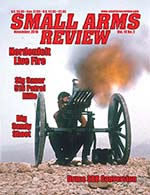By James L. Ballou
One of the prime movers behind the scenes in the production of the BAR was Edwin Pugsley. He was a giant of a man and as CEO of Winchester attended to the details of production and experimental firearms. Not much has been written about him except in the book on the BAR, Rock in a Hard Place. In it is described how Mr. Pugsley took the only prototype that Colt had to Winchester to make production drawings over a single weekend. Only a man of Pugsley’s stature could have pulled an entire engineering staff together to accomplish such a massive and precise undertaking. Edwin had joined the staff as an engineer in 1911 and rose through the ranks to eventually become president and CEO of WRA.
A little known but amusing anecdote of Mr. Pugsley is that a neighbor of his, Charles Addams, a noted writer and cartoonist for the New Yorker magazine, immortalized Edwin Pugsley in the campy, creepy classic cartoon The Addams Family. Pugsley became the mundane and morose son of Morticia and Gomez Addams. Though amused, Edwin was far more proud of his award winning design work on a sundial, which today sits beautifully in a garden at Old Mystic Seaport in Connecticut.
Pugsley’s genius in addition to working on difficult production problems was dealing with other design genius’ and their weird and irascible behavior. He ran interference with David Marshall “Carbine” Williams on the M1 Carbine. He also worked with Elmer Keith on the M70 - he was not a problem but a legend in his own time. Pugsley was a man of strong character with genius abilities, but was also an artistic thoughtful man. A true Renaissance man whose guidance of Winchester and their products live in the classic weapons we all know.
One of Mr. Pugsley’s and “Marsh” Williams’ designs did not make it to production, though it should have.
The Winchester Automatic Rifle: the WAR
In 1943, work began on a possible replacement for the venerable BAR. In mid 1944, the army published requirements for the possible replacement. This would be a difficult task since the BAR was such a unique and respected weapon.
Winchester led the way in this program with the T-20 series; the modified M1 Garands. The whole Garand series of T-20s with a BAR magazine was entirely too light for the full auto role, a fact that was rediscovered in the late fifty’s with the M14 and M15. The whole T-20 story is well illustrated and told in WHB Smith’s classic Small Arms of the World, Eighth Edition.
What is glossed over, without photo or explanation, was the “in house “Winchester designed WAR (Winchester Automatic Rifle): a spinoff of the G30R program attributed to David Marsh Williams of M1 Carbine fame. In fact, it looks rather like an M1 on steroids. Utilizing the famous tappet system so successful in the carbine, it also has elements of John Garand’s famous rifle. This is not farfetched since Winchester was a prime contractor on M1 rifles.
The WAR story became reality to this author on July 12, 1996 when Steven Beatty, Curator of the Springfield Armory Museum NHS held one of these gingerly in his hands, serial number 12. He proudly proclaimed, “All the major sources say that ten of these were fabricated. Even Winchester doesn’t have this one.”
From the photos you can see that it has a slightly curved 20-round magazine and a spindly bipod. It utilizes a turning bolt and a cammed operating rod similar to the M1 Carbine. It is selective fire with a lever located on the top left hand side of the receiver - sure to get hot after a few rounds.
Obviously, this rifle would not stand the abuse the BAR will, but it would have made a beautiful sporting rifle. The only good source of information on this fascinating but obscure rifle was written by Konrad Schreier, Jr. for Armax, the Journal of the Cody Firearms Museum in 1990.
This article first appeared in Small Arms Review V14N2 (November 2010) |
| SUBSCRIBER COMMENT AREA |
Comments have not been generated for this article.






